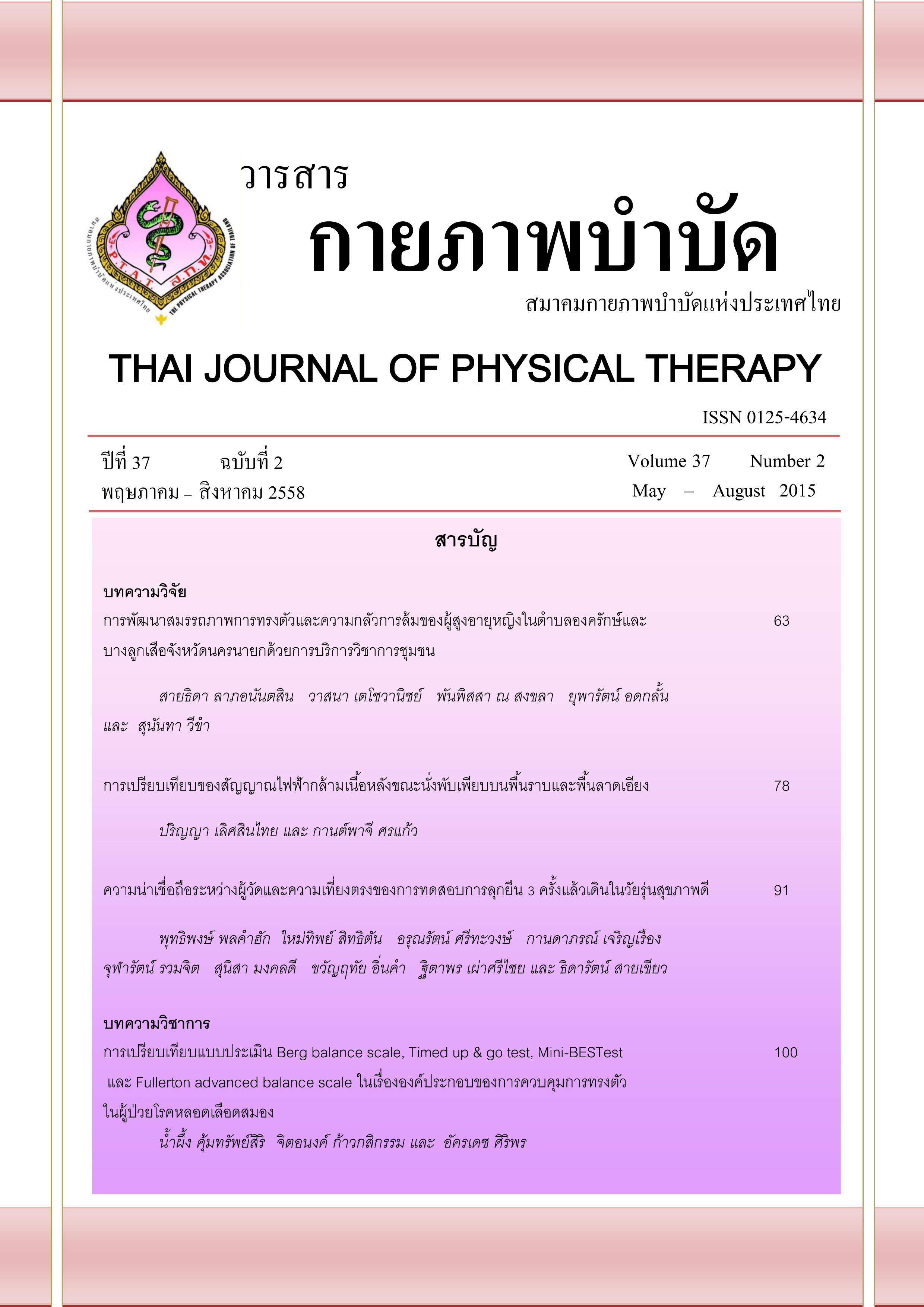ความน่าเชื่อถือระหว่างผู้วัดและความเที่ยงตรงของการทดสอบการลุกยืน 3 ครั้งแล้วเดิน ในนิสิตสุขภาพดี
Main Article Content
บทคัดย่อ
การใช้ทดสอบความสามารถทางกายมาเป็นตัวบ่งชี้ความเสื่อมถอยของร่างกายและความเสี่ยงต่อการล้ม ถือเป็นอีกวิธีการที่มีประโยชน์และง่ายต่อการนำไปประยุกต์ใช้ในการประเมินผู้สูงอายุในชุมชน ดังนั้นการศึกษานี้จึงมีวัตถุประสงค์เพื่อ พัฒนาและประเมินคุณสมบัติของการทดสอบทางกายที่พัฒนาขึ้นมาใหม่ คือ three times sit and walk test (TTSW) ในอาสาสมัครนิสิตสุขภาพดี มหาวิทยาลัยพะเยา จำนวน 30 คน โดยอาสาสมัครทั้งหมดจะได้รับการประเมินเบื้องต้นเกี่ยวกับข้อมูลพื้นฐานทั่วไป และรับการทดสอบการทดสอบลุกนั่งสามครั้งแล้วเดิน การทดสอบ timed up and go test (TUGT) และการทดสอบ five times sit to stand test (FTSST) โดยข้อมูลทั้งหมดถูกนำมาวิเคราะห์ ความน่าเชื่อถือระหว่างบุคคล (inter tester reliability) ความเที่ยงตรงตามสภาพ (concurrent validity) ผลการศึกษาพบว่า การทดสอบ TTSW มีความน่าเชื่อถืออยู่ในระดับดีเยี่ยม (ICCs = 0.991; 95%CI=0.984-0.996) และการทดสอบ TTSW มีความสัมพันธ์กับการทดสอบ FTSST และ TUGT อยู่ในระดับดี (0.648; p < 0.001, 0.673; p < 01001, ตามลำดับ) ดังนั้นการศึกษานี้จึงสรุปได้ว่า การทดสอบ TTSW มีความเที่ยงตรงและมีความน่าเชื่อถือสำหรับการนำไปใช้ประเมินความสามารถทางกายในนิสิตสุขภาพดี
Article Details
เอกสารอ้างอิง
2. Studenski S, Duncan PW, Chandler J, Samsa G, Prescott B, Hogue C, et al. Predicting falls: the role of mobility and nonphysical factors. J Am Geriatr Soc 1994; 42: 297-302.
3. Brians LK, Alexander K, Grota P, Chen RW, Dumas V. The development of the RISK tool for fall prevention. Rehabilitation nursing : the official journal of the Association of Rehabilitation Nurses 1991; 16: 67-9.
4. Tinetti ME. Factors associated with serious injury during falls by ambulatory nursing home residents. J Am Geriatr Soc 1987; 35: 644-8.
5. Daubney ME, Culham EG. Lower-extremity muscle force and balance performance in adults aged 65 years and older. Physical therapy 1999; 79: 1177-85.
6. Wrisley DM, Kumar NA. Functional gait assessment: concurrent, discriminative, and predictive validity in community-dwelling older adults. Physical therapy 2010; 90: 761-73.
7. Buatois S, Perret-Guillaume C, Gueguen R, Miget P, Vancon G, Perrin P, et al. A simple clinical scale to stratify risk of recurrent falls in community-dwelling adults aged 65 years and older. Phys ther 2010; 90:550-60.
8. Boulgarides LK, McGinty SM, Willett JA, Barnes CW. Use of clinical and, impairment-based tests to predict falls by community-dwelling older adults. Physical therapy 2003; 83: 328-39.
9. Shumway-Cook A, Brauer S, Woollacott M. Predicting the probability for falls in community-dwelling older adults using the Timed Up & Go Test. Physical therapy 2000; 80: 896-903.
10. Viccaro LJ, Perera S, Studenski SA. Is Timed Up and Go Better Than Gait Speed in Predicting Health, Function, and Falls in Older Adults? J Am Geriatr Soc 2011; 59: 887-92.
11. Montes J, Cheng B, Diamond B, Doorish C, Mitsumoto H, Gordon PH. The Timed ‘Up and Go’ test: predicting falls in ALS. Amyotroph Lateral Scler 2007; 8: 292–5.
12. Walker C, Brouwer BJ, Culham EG. Use of visual feedback in retraining balance following acute stroke. Phys Ther 2000; 80: 886-95.
13. Arnold CM, Faulkner RA. history of falls and the association of the timed up and go test to falls and near-falls in older adults with hip osteoarthritis. BMC Geriatr 2007; 7: 17.
14. Kristensen MT, Foss NB, Kehlet H. Factors with independent influence on the ‘timed up and go’ test in patients with hip fracture. Physiother Res Int 2009; 14: 20-41.
15. Yeung TS, Wessel J, Stratford PW, MacDermid JC. The timed up and go test for use on an inpatient orthopaedic rehabilitation ward. J Orthop Sports Phys Ther 2008; 38: 410–7.
16. Bohannon RW. Measurement of Sit-to-Stand Among Older Adults. Top Geriatr Rehabil 2012 Jan-Mar; 28: 11-6.
17. Whitney SL, Wrisley DM, Marchetti GF, Gee MA, Redfern MS, Furman JM. Clinical measurement of sit-to-stand performance in people with balance disorders: validity of data for the Five-Times-Sit-to-Stand Test. Phys ther 2005; 85: 1034-45.
18. Campbell AJ, Borrie MJ, Spears GF. Risk factors for falls in a community-based prospective study of people 70 years and older. Journal of gerontology 1989; 44: 112-7.
19. Akobeng AK. Understanding diagnostic tests 1: sensitivity, specificity and predictive values. Acta paediatrica 2007; 96: 338-41.
20. Puttipong Poncumhak , Nawapol Prasittimet, Peerasak Manota. The Pilot Study on the Risk of Fall Prediction in Thai Elderly Using Five Times Sit-to- Stand Test. Srinagarind Med J 2014; 29: 237-42.
21. Portney LG WM. Foundations of clinical research applications to practice. New Jersey: Prentice Hall Inc; 2000.
22. F. DR. Scale Development: Theory and Applications. 2nd ed. California: Thousand Oaks Inc; 2003.
23. Herman T, Giladi N, Hausdorff JM. Properties of the 'Timed Up and Go' Test: More than Meets the Eye. Gerontology 2011; 57: 203-10.
24. Luukinen H, Koski K, Laippala P, Kivela SL. Predictors for recurrent falls among the home-dwelling elderly. Scandinavian journal of primary health care 1995; 13: 294-9.
25. Podsiadlo D, Richardson S. The timed "Up & Go": a test of basic functional mobility for frail elderly persons. J Am Geriatr Soc 1991; 39: 142-8.
26. Buatois S, Perret-Guillaume C, Gueguen R, Miget P, Vancon G, Perrin P, et al. A Simple Clinical Scale to Stratify Risk of Recurrent Falls in Community-Dwelling Adults Aged 65 Years and Older. Phys ther 2010; 90: 550-60.
27. Lin MR, Hwang HF, Hu MH, Wu HDI, Wang YW, Huang FC. Psychometric comparisons of the timed up and go, one-leg stand, functional reach, and Tinetti balance measures in community-dwelling older people. J Am Geriatr Soc 2004; 52: 1343-8.
28. Morris R, Harwood RH, Baker R, Sahota O, Armstrong S, Masud T. A comparison of different balance tests in the prediction of falls in older women with vertebral fractures: a cohort study. Age and ageing 2007; 36: 78-83.


